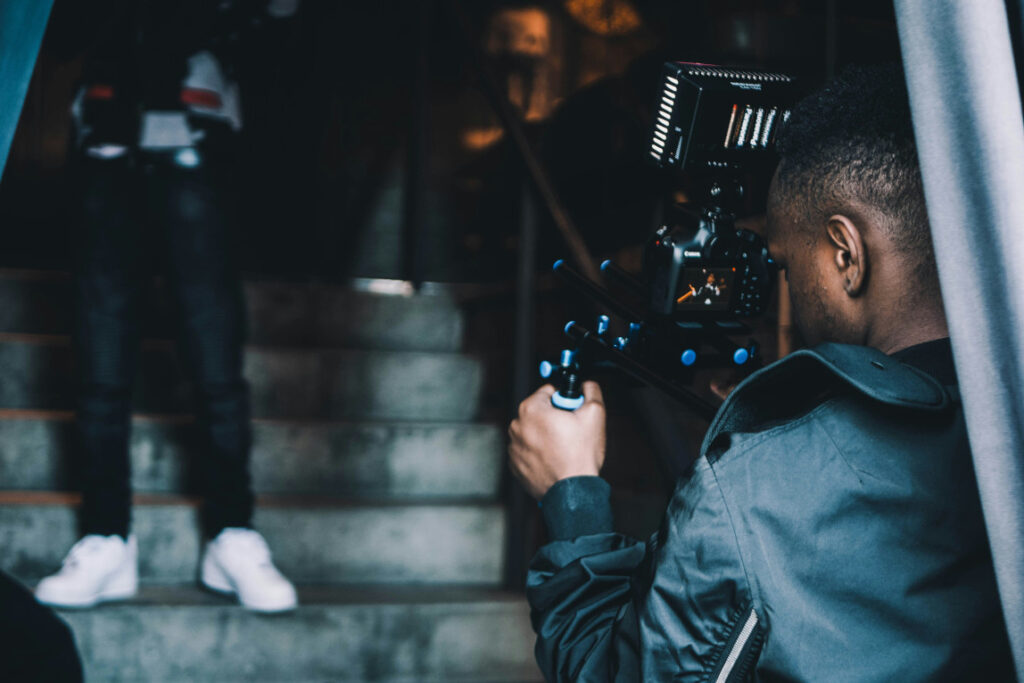
Music Videos are a key addition to your music. Not only do they allow you to showcase your music alongside interesting visual narratives or bring to life a band performance, music videos are great visual content that can be edited and repurposed for use across multiple platforms.
When planning your video there a number of aspects to consider. Your first port of call is to decide which song you are filming a video for, next, you need to consider the following creative and logistical aspects:
– Video type (e.g., band performance, narrative driven film requiring acting, or a mixture of both elements).
– Location (e.g., inside and/or outside setting [always check legal restrictions around access and noise levels etc., whether hiring a venue or making use of an outside space. Use of public spaces may require permission – check with your local council/organisation]).
– Transport to location
– Gear required (both for creating the video and to be included in it – key for performance videos).
– Costumes/ clothing choice
– Make-up/ special FX make-up
– Additional actors/ audience members
Early Planning Stages
Budget
It is best to establish early on, and prior to contacting any videographers, what your budget is. Your budget will vary depending on your personal circumstances, however, do consider the wide scope of use music videos can provide in terms of digital visual content. Music videos are powerful promotional tools in terms of helping your music reach wider audiences, so, if possible, do consider investing more into producing a good quality video. This being said, there are a number of ways in which costs can be kept to a minimum through DIY around props and costumes, involving friends as ‘audience’ members in performance videos or as background actors. If you are creating a larger production you may also wish to hire additional crew members, make-up artists, hair stylists and assistants.
The cost of producing your video will be impacted by the type of video you want to produce and if it requires hiring one or even multiple venues in order to bring your ideas to life. The videographer costs and any venue hire costs will most likely make up the bulk of your expenses. If you are choosing to film in a public location, especially if it is outdoors, you will need to check local laws and regulations around access and any noise restrictions (this is key if you’re filming with an acoustic drum kit and using loud speakers to film against the recorded track). If you are filming outdoors or in public, always be respectful of your surroundings, any wildlife and other humans.
Choosing Your Videographer
Selecting your videographer can make or break your video. If you’re unsure where to begin, have a look at videos by bands local to you and ask about their filming experience. A good videographer will have a show reel, and will showcase their work on their own website and/or social media channels. When watching through examples of work, don’t focus solely on the video content as it may not be in the style of what you would choose, but also consider the use of camera angles, color grading and any use of visual effects. It can also be worth looking at videos by bands of other musical genres to gain inspiration.
It is useful to have an idea of what type of video you want to make when contacting a potential videographer. If you have examples of other videos containing aspects you would like to incorporate, include those in your enquiry. Explain a bit about yourself as a band/artist, about your ‘brand’ and music genre, along with any themes. This will help to ensure you work with the person who is a best fit for your project, and assist in working out what is feasible to create.
Schedules And Shoot Details
So, your chosen location is arranged, the videographer and any additional crew members are booked in, now you need to finalize your plans for the day(s) of filming. More detailed narrative videos benefit from a ‘script’ or storyboard to ensure all involved understand exactly what scenes need to be filmed and where. If costumes/make-up differ across different scenes, you need to arrange your day most efficiently. For example, plan out filming scenic shots or B-roll footage while costume changes are going on. If additional actors or audience members are involved, ensure they arrive in plenty of time, but also consider timings so that no one is left waiting around for several hours if they are not needed.
Extras To Consider
Music video shoots are a great opportunity for creating additional social media content, particularly behind the scenes content. If all band members are too busy on the day, or are likely to forget, ask a friend along to snap some behind the scenes pictures and video clips – a mixture of both will be helpful for sharing across multiple social media platforms, and are useful for sharing on Patreon or in newsletters to your fans.
What To Do When Things Go Wrong
Even the best laid plans can go awry. Perhaps the weather is against you, only half of your audience members have turned up, you’ve left the microphone stands at home or misplaced your favourite guitar pick. A good videographer will assist in working with what you have, for example, carefully chosen camera angles can make a small group of people look like a larger audience. Don’t be afraid to experiment and try out ideas on the day as you might discover something works more effectively than initially planned.
If the issues are more significant and require rescheduling the day, it is better to do so and ensure you are happy with the final product. This is partly why it is recommended to film any music videos significantly in advance of any chosen release dates. Avoid filming a video a week before it’s due to release as there may be issues on the day, or perhaps the editing process takes longer than expected to achieve the quality you are after. If however, the video takes longer to produce (for whatever reason) and the chosen release date isn’t met, make sure you inform your PR so they are aware of what is going on, and alternative arrangements can be made.
